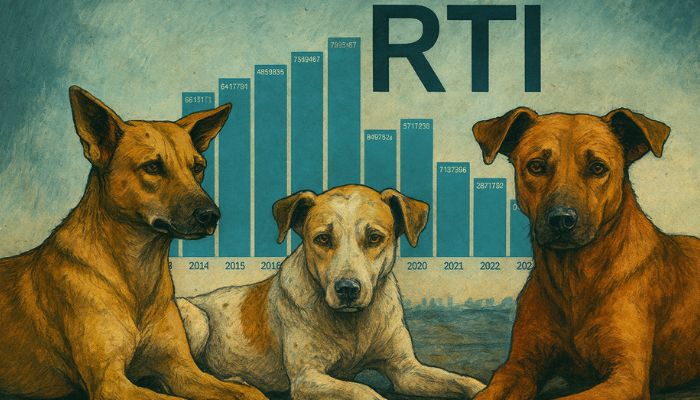OpIndia Exclusive: Stray dog menace in India is worsening – RTI reveals 26 lakh cases in just 7 months, crores of victims over the years, ABC Rules are a complete failure
By Anurag
Copyright opindia

The stray dog menace in India is much worse than officially acknowledged, with millions of bite cases every year exposing a public health and safety crisis of staggering proportions. In a reply to an RTI filed by OpIndia in connection with dog bite data across the country, the Union Government has informed that in 2025 alone, so far, there were over 26 lakh cases reported. In its reply, the Directorate General of Health Services, National Centre for Disease Control (NCDC), said that there were 26,71,732 cases of dog bites reported in India till 31st July.
OpIndia had sought information on state-wise data from 2001, when ABC Rules first came into force till 31st July 2025. However, centralised state-wise data was first maintained in 2012. This is a problem in itself. Despite India recording the world’s highest number of rabies cases, there was no centralised state-wise data until 2012, even though the ABC Rules had come into effect in 2001.
Stray dog menace is worsening in the country
OpIndia received the data between 2012 and 31st July 2025. While there were several other questions included in the RTI, most of the answers were not provided as those were to be answered by other departments. In this report, we have concentrated on annual dog bite cases, state-wise dog bite load and rabies deaths officially recorded by the Government of India.
The data provided by NCDC has been retrieved from the Integrated Disease Surveillance Programme–Integrated Health Information Platform (IDSP-IHIP). What makes the data alarming is the fact that the monthly average for 2025 is already higher than the monthly average of 2024, which points towards the fact that the stray dog menace is worsening in the country.
According to the data, there were 3,81,676 cases of dog bites every month in this year till 31st July 2025. The number is significantly higher, as in 2024, the monthly average was 3,09,778 per month. It means India is reporting almost 80,000 more dog bite cases in 2025 compared to the previous year.
This RTI is part of OpIndia’s ongoing investigation into the stray dog menace that has engulfed the country. It has exposed not only the scale of the problem but also the failures of sterilisation and rabies control programmes. While activists and NGOs continue to claim that the problem is exaggerated, the government’s own numbers present an undeniable reality.
What the RTI reply says
The RTI reply provided year-wise figures of dog bite cases for every state and Union Territory from 2012 up to July 2025. For the period between 2012 and 2021, the data was retrieved from the IDSP portal under what is known as the P form. This reporting format, however, carried a critical gap. Notably, rabies deaths were not provided between 2012 and 2021.
That means, for almost a decade, the Government of India did not collect data on rabies deaths across India. Interestingly, the World Health Organisation claims that there are around 20,000 rabies deaths every year in India, which is based on a Parliamentary reply given by the Government of India a couple of decades back. Recent studies show that the rabies load in India could be over 5,000. However, the government data shows under 100 deaths every year since 2022.
From 2022 onwards, the government shifted to the IDSP-IHIP portal, where the information is logged under the Presumptive form. In practical terms, this means that the figures are provisional tallies collected at field level for immediate surveillance purposes, and while they may be revised later, they already reveal a staggering picture. Even as “presumptive” counts, the numbers cross into millions, highlighting the depth of the crisis.
Interestingly, the national total saw a steady climb between 2012 and 2019, with 42,51,977 cases reported in 2012 and 72,69,410 cases reported in 2019.
Then in 2020, there was a massive dip owing to the COVID years. In 2020, the number dropped to 47,58,041 and it kept dropping till 2022, when there were 21,90,056 dog bite cases reported.
However, following that year, there was a steep jump in the numbers, with 30,52,324 dog bite cases in 2023 and 37,17,336 cases in 2024. By July 2025, India had already logged over 26 lakh cases, and if it keeps increasing at this pace, India may report well over 45 lakh dog bite cases in the current year.
The data also throws up peculiarities that underline the diversity of India’s policies on animal control. Lakshadweep, for instance, has consistently reported zero cases. The reason is not statistical luck but policy clarity. The island territory does not allow dogs at all. Even tourists are prohibited from bringing pet dogs with them. In stark contrast, mainland states and other Union Territories continue to record hundreds of thousands of cases every year, showing just how wide the gulf is between firm preventive policies and ad hoc, ineffective approaches.
Year-wise national trend
The figures reveal a troubling national trajectory. In 2012, India reported just over 42.5 lakh dog bite cases. This number climbed steadily year after year and in 2018, it breached the 75 lakh mark, the highest in the dataset. The surge highlighted the failure of sterilisation drives and the unchecked expansion of stray dog populations across both urban and rural India.
Then came the dramatic fall due to the COVID years. However, the downward trend did not last long. By 2023, the country breached the 30 lakh dog bite cases per year. There are a lot of questions regarding the data available for the years 2020, 2021 and 2022. In 2020, for most of the months, India was locked inside due to the nationwide lockdown. Still, there were well above 47 lakh dog bite cases. However, in the coming two years, when lockdown was over, the number of dog bites kept falling. There is a possibility that for those years, as the country was struggling with wave after wave of the COVID-19 virus, the dog bite cases were not reported properly.
In case of rabies deaths, the data has been provided only for 2022 (21), 2023 (50), 2024 (52) and 2025 (23 till 31st July).
Don’t get misled by post-pandemic fall in dog bite cases
The self-styled dog lovers may argue that between 2020 and 2022, the stray dog menace was brought under control. In reality, however, it is far more sobering. These were the years when COVID-19 brought the country to a standstill. As people were locked inside, and even after the lockdown was lifted, people preferred to go out only if necessary to avoid infection, which reduced dog–human contact.
Furthermore, as the hospitals were overwhelmed by COVID-19 cases, there is a chance people did not go to hospital to get treatment for dog bites, fearing COVID infection. Under-reporting, rather than actual reduction, drove the numbers down. Equally, data collection suffered as government machinery was diverted almost entirely to pandemic duties.
Surveillance officers, health workers, and municipal authorities had limited capacity to log or verify dog bite incidents. For this reason, the decline seen in those years cannot be read as evidence of effective sterilisation or management. It was a statistical distortion born out of extraordinary circumstances. The rebound after 2022 confirms that the menace never went away; it was only masked temporarily by the disruptions of COVID.
State-wise picture
A closer look at the state-level data shows how deeply entrenched the problem is across the country. The state of Uttar Pradesh has consistently topped the chart. The annual figures in UP often cross the 10 lakh mark and peaked at more than 20 lakh during the pre-pandemic years. Post COVID years, the dog bite cases have, however, remained under 5,00,000 per year.
Bihar, Andhra Pradesh and Madhya Pradesh are among the states that bore the most load of dog bite cases and contributed heavily to the national totals. Each of these states has recorded hundreds of thousands of cases every year. States such as Maharashtra, West Bengal and Rajasthan, while slightly lower in comparison, still show six-figure counts, making clear that no part of India has escaped the menace.
In 2024, states with maximum dog bite cases were Madhya Pradesh (1,42,953), Uttar Pradesh (1,64,009), Assam (1,66,232), Odisha (1,66,790), Andhra Pradesh (2,45,166), Bihar (2,63,925), Karnataka (3,61,306), Gujarat (3,92,652), Tamil Nadu (4,80,425) and Maharashtra (4,85,349).
Even smaller states and Union Territories paint a grim picture of the problem. Assam, for instance, registered over 1,66,000 cases in 2024. On the other hand, Kerala has seen yearly figures that touched or crossed the 1,00,000 mark in the past decade. The only exception is Lakshadweep, which reports no dog bite cases at all, owing to its unique policy of prohibiting dogs on the islands. This sharp contrast between zero cases in one Union Territory and millions elsewhere illustrates how decisive governance measures can completely change the public health outcome.
The problem of presumptive reporting
The RTI reply makes it clear that the data since 2022 is drawn from the Presumptive form under the IHIP portal. This distinction matters. Presumptive data is provisional. It is collected at the field level by a medical officer for immediate surveillance, often without medical verification or laboratory confirmation. While such reporting ensures rapid availability of information, it also raises questions about accuracy and completeness. The fact that even these provisional tallies run into millions underscores how dire the actual situation must be.
Another equally problematic issue is the gap in earlier years. Between 2012 and 2021, rabies deaths were not recorded, which means India’s surveillance system essentially ignored the fatal dimension of the crisis for nearly a decade. Not to forget, rabies is not a notified disease. That means there is no compulsion on hospitals and labs to report rabies.
Together, these limitations suggest that the problem may be worse than what the RTI figures themselves show. Far from minimising the menace, the “presumptive” nature of the data should ring alarm bells, because if provisional counts are this high, the confirmed burden must be more staggering.
Accountability of government and NGOs
Over the years, Central and State governments have poured crores of rupees into sterilisation and vaccination drives with negligible success. Instead of a sustained decline in dog bite cases, India witnessed a rise up to 2018, followed by a pandemic-induced dip, and now a return to alarming numbers. This clearly suggests that sterilisation programmes under the Animal Birth Control (ABC) framework have failed to deliver meaningful results.
There are hundreds, if not thousands, of NGOs and individuals working specifically for “dog welfare”. They claim to carry out regular sterilisation and vaccination of stray dogs. Many of these organisations have been roped in by the Animal Welfare Board of India and state-level animal welfare boards to run sterilisation drives. However, as mentioned in previous articles, many of them have been found to be submitting forged data.
Another problem is that most of these NGOs and individuals do not publish audit data that can be cross-checked. Furthermore, neither states nor the central government has any specific portal where such data can be found and checked. Everything is opaque in the world of “dog welfare”. Deeper investigation is required by central agencies to find out where the money is going that is being given to these NGOs and what is happening to the money collected through fundraisers by these NGOs and individuals. Accountability, both of state authorities and self-proclaimed animal welfare organisations, is glaringly absent, which needs to be rectified immediately.
The victims: Ordinary Indians
Behind these millions of reported cases are ordinary Indians. Children walking to school, elderly people stepping out for a morning walk, families in rural areas with little access to immediate medical care, disabled persons, delivery partners, house helps and other vulnerable people. Each figure in the RTI reply represents a person forced to undergo the painful and costly rabies vaccination process and post-incident care. These people have often been attacked by the dogs without provocation. In some extreme cases, plastic surgery and months-long medical care are needed, which is impossible for poor households to manage.
Hospitals, especially in smaller towns, are overburdened with cases of dog bites, diverting resources from other health priorities. In villages, where vaccine availability is inconsistent, victims may have to travel miles or even go without treatment, exposing them to the fatal risk of rabies. The menace is not only a health crisis but also a social and economic burden borne disproportionately by the most vulnerable. While NGOs and activists debate the “rights” of stray dogs, it is citizens who pay the price, both financially and with their safety.
Conclusion: The ABC Rules are ineffective and largely removed from reality
The RTI reply demolished any lingering illusion that India’s stray dog menace can be brought under control with ABC programmes under ABC Rules 2023. With over 26 lakh cases already reported by July 2025, the crisis has returned to pre-pandemic levels. The trajectory points towards another year of staggering totals. Years of sterilisation drives, crores of rupees in funding, and repeated court interventions have failed to prevent millions of Indians from falling victim to dog bites.
It is a gross institutional failure that hides behind “animal welfare”. Meanwhile, ordinary citizens continue to face the danger every day, with children and the poor paying the heaviest price.
The RTI reply is more than just numbers. It is proof, on official government letterhead, that India’s stray dog policies are failing. The question is whether the Supreme Court, the central government and the state governments are going to consider unconventional steps by dropping the capture-sterilise-vaccinate-release methodology, or whether 2026 is going to get even worse.
This is the first RTI-based article in OpIndia’s Stray Dog Menace series. Additional data on several parameters is awaited and will be examined in detail in forthcoming articles.
OpIndia is doing a series on Stray Dog Menace that can be checked here.



